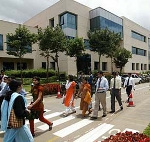Bangalore: silicon (v)alley?
 A few weeks ago I went to Bangalore for the first time with some of my colleagues from Bridge India to attend a social media event. Last week I went once more to attend management training. Visiting the biggest IT center of India, I questioned myself: is Bangalore becoming the (second) silicon valley of the world or not?
A few weeks ago I went to Bangalore for the first time with some of my colleagues from Bridge India to attend a social media event. Last week I went once more to attend management training. Visiting the biggest IT center of India, I questioned myself: is Bangalore becoming the (second) silicon valley of the world or not?
Related to this question is the prediction that I frequently hear in our industry: in 15-20 years the cost differences between India and the Western countries will disappear. Now I don’t know how much value images of a city have in answering these questions, but for people who haven’t been to Bangalore, I just wanted to show the ‘contradictions’. These are the ‘two worlds’ that you get to see when visting Bangalore:

For more pictures, you can visit our facebook photo page:http://www.facebook.com/album.php?aid=299438&id=115213254738&page=2
Our own office is located in Cochin and I can absolutely feel a different ‘spirit’ when visiting Bangalore. In Bangalore people have an entrepreneurial mindset and I don’t say Cochin lags it, but Bangolorite are motivated to contribute to the ‘Indian dream’ (which I believe is more about a collective Indian achievement than an individual achievement as the American dream about). And a lot of people make it happen (I even saw a Lamborghini drive around). But there is quite a way to go and because of the huge divide, there will in the next decades always be people who are ready to take a position at a low salary. In 2020, there are 1.6 million Indians and plenty of them believe IT and BPO are their paths to a better future. I think the Indian outsourcing industry will thrive and remain the growth engine of the Indian economy. And maybe in a few decades, when I visit again, the whole city (or country?) will look like Silicon Valley?
I am curious on other people’s experiences and views on this question.
Een paar weken geleden ging ik voor het eerst naar Bangalore met enkele van mijn Bridge India collega’s om een social media event bij te wonen. Vorige week ben ik nogmaals geweest om een management training bij te wonen. Terwijl ik het grootste IT centrum van India bezocht vroeg ik me af of Bangalore de (tweede) silicon valley van de wereld aan het worden is.
Vaak hoor ik in onze industrie de voorspelling dat over 15-20 jaar de kostenverschillen tussen India en de westerse landen zullen verdwijnen. Ik weet niet hoe veel plaatjes u in uw hoofd heeft als u denkt aan Bangalore, maar ik wil graag de ‘tegenstellingen’ laten zien. Dit zijn de ‘twee werelden’ die u zult zien als u Bangalore bezoekt:
 A few weeks ago I went to Bangalore for the first time with some of my colleagues from Bridge India to attend a social media event. Last week I went once more to attend management training. Visiting the biggest IT center of India, I questioned myself: is Bangalore becoming the (second) silicon valley of the world or not?
A few weeks ago I went to Bangalore for the first time with some of my colleagues from Bridge India to attend a social media event. Last week I went once more to attend management training. Visiting the biggest IT center of India, I questioned myself: is Bangalore becoming the (second) silicon valley of the world or not?
Vor einigen Wochen fuhr ich, mit einigen meiner Kollegen von Bridge India, zum ersten Mal nach Bangalore, um einem Social Media Event beizuwohnen. Letzte Woche bin ich noch einmal dort hingefahren, um einem Management Training beizuwohnen. Das größte IT Center Indiens besuchend, fragte ich mich: Wird Bangalore das zweite Silicon Valley der Welt, oder nicht?
Voor meer foto’s kunt u onze facebook fotopagina bezoeken:http://www.facebook.com/album.php?aid=299438&id=115213254738&page=2
Ons eigen kantoor is in Cochin en ik voel absoluut een andere mindset als ik Bangalore bezoek. In Bangalore hebben mensen een ondernemersgeest en ik zeg niet dat Cochin dat niet heeft, maar de mensen in Bangalore zijn gemotiveerd om bij te dragen aan de ‘Indiase droom’ (en dat is volgens mij meer een collectieve droom dan de Amerikaanse droom die alom bekend is). En veel mensen krijgen het voor elkaar (ik zag zelfs een Lamborghini rond rijden). Maar ze hebben nog een lange weg te gaan vanwege de enorme kloof tussen arm en rijk, in de komende jaren zullen er altijd mensen zijn die een baan aannemen tegen een laag loon. In 2020 zullen er 1.6 miljoen Indiers zijn en veel van hen geloven dat IT en BPO hen een betere toekomst kunnen brengen. Ik denk dat de Indiase outsourcing industrie succesvol zal zijn en een grote factor in de groei van de Indiase economie zal blijven. En misschien over een paar jaar als ik Bangalore weer bezoek zal de hele stad (of het hele land?) er uit zien als Silicon Valley?
Ik ben benieuwd wat de ervaringen en meningen van anderen zijn over dit onderwerp.
Related to this question is the prediction that I frequently hear in our industry: in 15-20 years the cost differences between India and the Western countries will disappear. Now I don’t know how much value images of a city have in answering these questions, but for people who haven’t been to Bangalore, I just wanted to show the ‘contradictions’. These are the ‘two worlds’ that you get to see when visting Bangalore:

For more pictures, you can visit our facebook photo page:http://www.facebook.com/album.php?aid=299438&id=115213254738&page=2
Our own office is located in Cochin and I can absolutely feel a different ‘spirit’ when visiting Bangalore. In Bangalore people have an entrepreneurial mindset and I don’t say Cochin lags it, but Bangolorite are motivated to contribute to the ‘Indian dream’ (which I believe is more about a collective Indian achievement than an individual achievement as the American dream about). And a lot of people make it happen (I even saw a Lamborghini drive around). But there is quite a way to go and because of the huge divide, there will in the next decades always be people who are ready to take a position at a low salary. In 2020, there are 1.6 million Indians and plenty of them believe IT and BPO are their paths to a better future. I think the Indian outsourcing industry will thrive and remain the growth engine of the Indian economy. And maybe in a few decades, when I visit again, the whole city (or country?) will look like Silicon Valley?
I am curious on other people’s experiences and views on this question.
Bezogen auf diese Frage, ist die Vorhersage, die ich oft in unserem Wirtschaftszweig höre: In 15-20 Jahren werden die Kostenunterschiede zwischen Indien und westlichen Ländern verschwinden. Nun weiß ich nicht wie viel Wert die Bilder einer Stadt bei der Beantwortung dieser Frage haben, aber ich wollte nur die „Widersprüche“ aufzeigen. Dies sind zwei Welten, die man sieht, wenn man Bangalore besucht:
Um mehr Bilder zu sehen, können Sie unsere Facebook Bilderseite besuchen: http://www.facebook.com/album.php?aid=299438&id=115213254738&page=2
Unser eigenes Büro befindet sich in Kochi und ich einen anderen „Stimmung“ wahrnehmen, wenn ich Bangalore besuche. In Bangalore haben die Menschen unternemerische Denkweise und ich will nicht sagen, dass Kochi dies nicht hat, aber die Menschen in Bangalore sind motivierter etwas zu dem „indischen Traum“ (welcher meiner Meinung nach mehr mit der kollektiven indischen Leistung, als mit der individuellen Leistung, wie zum Beispiel im Konzept des „American Dreams“, zu tun hat).beizutragen. Und viele Leute lassen diesen Traum wahr werden. (Ich habe sogar einen Lamborghini herumfahren sehen). Aber es liegt noch ein weiter Weg vor ihnen und aufgrund der großen Kluft zwischen Arm und Reich, wird es in den nächsten Jahrzehnten immer Leute geben, die bereit sind einen Posten mit einem geringen Gehalt einzunehmen. In 2020 wird es 1.6 Inder geben und viele von ihnen glauben, dass IT und BPO ihr Weg in eine bessere Zukunft ist. Ich denke, dass die indische Outsourcing Industrie florieren wird und der Motor für das Wachstum der indischen Wirtschaft bleiben wird. Und vielleicht wird die ganze Stadt (oder das ganze Land?), wenn ich es in einigen Jahrzehnten wieder besuche, aussehen wie Silicon Valley?
Ich in gespannt auf die Erfahrungen und Sichtweisen anderer Leute bezüglich dieser Frage.
Basis rules for creation sites for users
Grundregeln für die Erstellung von Seiten für Benutzer
Seit kurzem ist für viele Leute die Benutzerfreundlichkeit von Webseite ein beliebtes Gesprächsthema. Es ist ein sehr bekannten Wort, wenn man im IT Bereich arbeitet.
Benutzerfreundlichkeit ist eine Art Mantra für Projektmanager, Designer und Entwickler. Es es nicht genug eine Webseite oder ein Programm, das bestimmte Funktionen erfüllen wird, nur zu erschaffen. Jeder hat das Bedürfnis seine Seiten zu verbessern, sich einfacher und benutzerfreundlicher zu gestalten, um ihre Besucherrate etc. zu erhöhen.
Wenn ein Benutzer zum ersten Mal die Seite besucht, soll er nicht darüber nachdenken müssen, wie die Seite funktioniert, sondern sie einfach benutzen und einfach die Informationen finden, die er braucht. Bringen sie Nutzer nich dazu ihre grauen Zellen anzustrengen oder zum Nachzudenken; ermöglichen sie ihm einfach den Zugang zu den benötigten Informationen. Wenn es nicht eindeutig und klar ist, ist es nicht benutzerfreundlich – Das ist der Hauptgedanke.
Es gibt viele Definitionen für diesen Begriff und da Benutzerfreundlichkeit nicht messbar und eine subjektive Angelegenheit ist, versucht ihn jeder so gewählt wie möglich zu beschreiben. Tausende Bücher und Artikel sind darüber geschrieben worden, aber für den Augenblick möchte ich mich auf Eric Reiss beziehen, da ich vor einiger Zeit die Möglichkeit hatte einer seiner Vorlesungen zu besuchen und davon noch immer ziemlich beeindruckt bin.
Eric Reiss, eine der einflussreichsten Figuren der europäischen Informationsarchitektur- / Benutzerkomfort- / Benutzererfahrugs-Szene.
Die Vorlesung war einer Reihe von Regeln gewidmet (Eric nennt es Dogma), welche einem helfen Seiten für Benutzer, frei von den Zwängen der Technologie und der Mode, zu erstellen.
Dies sind die Regeln:
Alles, was nur dazu dient, interner Politik eines Seitenbesitzers zu genügen, muss beseitigt werden.
Alles, was nur dazu dient, das Ego des Designers zu befriedigen, muss beseitigt werden.
Und ganz egal, wie kreativ der Designer ist:
Die Benuzterfreundlichkeit darf nie dem Stil zuliebe geopfert werden.
Alles, was nicht mit dem Inhalt der Seite übereinstimmt muss beseitigt werden.
Jegliches Feature oder jegliche Technologie, welche die Freiheit der Seitennavigation einschränkt, muss korrigiert oder beseitigt werden.
Jegliches interaktive Objekt, welches den Beutzer dazu zwingt seine Funktion zu erraten, muss korrigiert oder gelöscht werden.
Abgesehen vom Browser selbst, darf keine zusätzliche Software erforderlich sein, so dass die Seite in korrekter Weise funktioniert.
Kein Besucher darf dazu gezwungen werden, sich zu registrieren oder persönliche Daten zu senden, es sei denn, der Besitzer der Seite ist ansonsten nicht in der Lage eine Dienstleistung zu erbringen oder eine Transaktion durchzuführen.
Können Sie sich erinnern, wie viele Webseiten Sie verlassen haben, nachdem Sie sich nicht mit der Navigation zurecht gefunden haben, wie viele Seiten Sie mit ihren „genialen“ Flash Intros oder Bannern verwirrt haben? Nein, Ich denke nicht, dass Sie sich an diese Webseiten erinnern. Sie haben diese sofort geschlossen und ihre Existenz vergessen. Das ist eine normale Reaktion, aber das ist nicht, was der Besitzer sich davon versprichen, wenn sie eine Webseite erstellen.
Es hört sich vielleicht dumm an, aber kontrollieren Sie, ob die Struktur der Seite, das Design und der Inhalt diesen Regeln entsprechen. Es wird helfen die Seite besser, einfacher und bekannter zu machen.






![bangalore-IT-hub_J5lx6fbCTLWC[1] bangalore IT hub J5lx6fbCTLWC1](https://www.bridge-global.com/blog//wp-content/uploads/2010/12/bangalore-IT-hub_J5lx6fbCTLWC1-150x150.jpg)
Very True.. may be after few years, you might need to write new Article with title: “Silicon: A New B’lore Valley”
Hi,
it has never been and will be the “second silicon valley” except some industry “titans” say so. here “silicon valley” means a place where cutting edge /product related original , gamechanging innovations emanates constantly. cost differences tend to dissappear and thats inevitable as source of conuinuous talent supply is yet to be identified . other countries dont have reliable output. outsourcing happens because of ridiculously high developers’s remuneration in “developed” countries and ageing population. unless there is no solution for that , nothing can stop outsourcing . costfactor is one of the concern. see AT kearney global skills report.
regards
vinodhsen
Hugo,
In regard to “the prediction that I frequently hear in our industry: in 15-20 years the cost differences between India and the Western countries will disappear,” I will say this is incorrect.
What is correct is that the process towards this is already well begun.
In the emerging global workplace (for some industries, at least), there is/will be no reason at all for anyone to pay one worker any more than any other, just because the one is better located, personally, than the other.
I agree with Shankar. The process is indeed already in play. Indian wages are uncontrollably rising, fueled by strong demand and a limited number of experienced professionals. Wages in the US are concurrently falling because of the shrinking job market. Soon the twain shall meet.
Hi Hugo,
Nice to connect again.
The Off shoring and BPO Industry is already contributing close to 5% of India’s GDP currently and this is slated to rise in the coming years. Close to 2.2million people are direct employees of this sector in India with around 40% + in Bangalore itself.
Will this go on, absolutely… will the price advantage of Bangalore continue, well maybe more Yes than No. The India Industry Captains are very committed to make this happen consistently over the next many years. Even in 2010, industry estimates the cost advantage to continue with the emergence of Tier 2 cities of India on the BPO maps. Quite a few captives now have offices in tier 2 cities as well. With India churning out over 3.5 million Graduates from colleges and universities every year, the talent pool is tremendous in all parts of the country and India is truly shining.
What is also changing for Bangalore is the depth and the breadth of the service offerings and almost anything can be done out of Bangalore now. In fact, many Bangaloreans are now engaged in seeding global BPOs and are experts who go into the Makati Cities of the world to start a BPO!
So, Bangalore or not, the India story seems to be intact at this time. Bangaloreans too have seen the city grow in leaps and bounds from 2000-01 when the first BPOs set up shop. It has only been 10+ years since; give it some time….10 years is a very miniscule time period on any scale. What makes the India story more profound is that the USD is still 45 times to INR and this is not going anywhere for a long time to come.
As for Bangalore, every city has an underbelly, but for Bangalore those realities are changing fast and the city is developing at a very rapid pace and who knows, maybe the whole of Bangalore will be like Silicon Valley sooner than later. The ability to have sailed through the worst recessions periods with hardly any job losses in Bangalore and greater focus on cost and operational efficiencies also make the story very tenable. To top it all we are gritty people, Hugo and will continue to make this happen.
Regards,
Amit